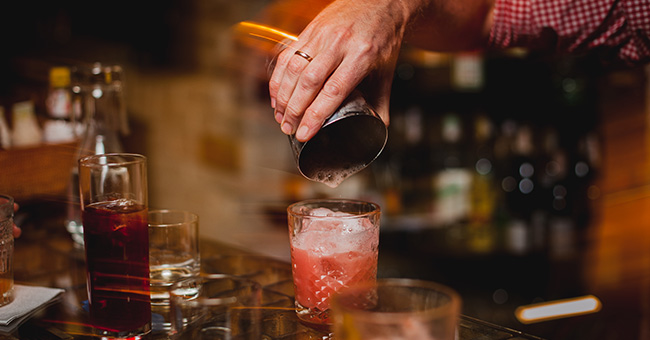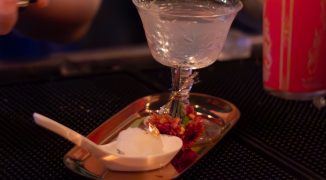It’s far too common to find restaurants with hot kitchens but tepid bars. How can your bar be part of the restaurant, with quality that sets it above the competition? Should you go for an extensive cocktail menu? Should you stay focused on a strong wine list? Rely on beers? Do you need cocktails at all?
Chris Cardone is a bartender at I Sodi and the owner of Continuous Beverage Solutions. As a bartender and a consultant, Cardone’s perspective is, on the surface, simple: What matters about what your bar program is that it shines. But how do you know what’s best for your bar?
Restaurant, know thyself
“As a group,” Cardone advises, “you have to say, ‘What is the ethos of the restaurant?’”
Once you know that, you have a sense of direction and an awareness of what you need. The place itself may be a deciding factor. If it’s going to be a French bistro or a burger joint with multiple TV screens showing sports, then you can set aside cocktail ambitions, start building an excellent wine or beer program and create the bar your customers crave.
Be extraordinary
“The truth is that almost everybody tries to be something everyone else is being,” Cardone says. That’s like setting out to be average. Creating an outstanding bar requires dedication, knowledge, focus and skill. To have a great bar, “You have to be exceptional at something.”
It’s important to know what your something is. “A lot of places say, ‘Oh, we need cocktails, because that’s hot right now,’ but they don’t really understand what goes into it,” Cardone observes. “They think that if they have rack of bitters or a couple of syrups or an infusion or two, they have a cocktail program. It’s so much more involved.”
Creating a cocktail program, from concept to opening to ongoing training and education, demands investments of cash and time. High-end liquor is expensive — and so are creative, capable bartenders. The important question is: Do you need them? If your aim is excellence, then it isn’t just a matter of what you can do. It’s what you can do brilliantly.
With the right ethos, budget and staff, you can have a breathtaking brew bar. With friendly, beer-savvy bartenders, great American food and sports on a flatscreen, you’ll have a packed house every night — and nobody will be upset that there isn’t a seasonal cocktail menu in sight.
Nothing is forever
“This is a growth thing,” Cardone says. “When you’re a brand spanking new restaurant, you can open up with three or four drinks on your soft menu and try to give it a feel. If it feels good, you can slowly, gradually open it up.”
And if it doesn’t? That’s okay. “As a bartender, your job is to find out what your guests want and to deliver that.” Whether you’re selling wine, beer or cocktails — aim high. “Do what you, but do it really well. Be exceptional at what you do, and be proud of it.”
Grow as you go
When he ran the Beatrice Inn, Cardone remembers, “We started off with four cocktails, and then it we built it up to six, and then it became eight, and next thing you know, we had 10. It was a gradual process. Same thing for training. We focused on just the basic cocktails, so the servers and the bartenders were fluent on what we did … We kept bringing in brand ambassadors to do trainings on the spirits themselves, and we would do trainings on the cocktail program and what foods to pair with. It’s no different from a wine or beer program; that’s an ongoing process, as well.”
The fine art of compromise
“When you decide to cut out part of your bar program — like cocktails — you’re losing out on sales.” Some people, Cardone observes, don’t like beer or wine. That said, “it doesn’t need to be a twenty-drink menu. It can be something very, very simple. Even having three or four drinks on a menu … It’s like places not having nonalcoholic beer; that’s a lost sale opportunity for anyone who doesn’t drink. It becomes ‘now that person has water.’”
If you’re going with beer or wine plus a brief cocktail list, choose from the classics. “Most classics are classics because they’re balanced and easily executable drinks.”
Teaching your bar staff to make a few classics isn’t expensive; it doesn’t require a hefty investment in spirits, and it can keep cocktail-drinking customers happy, so they’ll spend an evening sitting with their wine or beer-loving friends, eating, drinking and helping your business to pay the rent.
Build excellence
Think widely. “Having diversity is extremely important.” Many restaurant owners fall into a trap, Cardone says: “They purchase what they like, and they don’t think about what anybody else likes.”
That’s part of education. “As opposed to saying, ‘I like Heineken, so we have to carry Heineken,” there needs to be a reason for that product … The same goes for wine — ‘Oh, I really like white wine, so I’m going to carry ten white wines and two reds. It’s a trap that’s so commonly done, in our industry.” Offer diversity, and you increase the chances that everybody who walks through the door will find a wine or beer they like.
“Having a variety of common and well-known items creates a fun experience for the guest.” If someone wants a familiar glass, it’s there. “If someone wants adventure, that’s there, too.” Of course, your staff has to know how to talk about it — and how to read guests — but that’s a matter of education and training.
“The third thing is finding quality stuff at the right price point. You don’t want to walk into a place and have everything be $28 a glass. You want to have a balanced menu when it comes to price, too. That’s the never-ending job of a beverage director, a head bartender or a chef-owner.”
“You have to maintain an interest in your guests. You have to maintain an excitement level, not only for your guests, but for your staff, as well — to learn new things, to grow.”
Growth doesn’t mean moving toward serving only cocktails or no cocktails; it means getting better and better at what you do. It also means knowing whether, for this restaurant, brilliance means stirring martinis, offering a menu of known and unusual wines, or pouring the most conversation-worthy craft brew in town.




